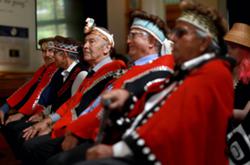
I recently read the Whitefish Handbook of Ecuador, a book that describes the fish Ecuador markets for export. On the page dedicated to South Pacific hake, the writer divulged that hake filets are marketed and sold as flounder, weakfish and tilapia. Hake sold as tilapia?
You know tilapia -- it is one fish everyone agrees is sustainable not least because it's farmed and grows on a vegetarian diet (so it does not require fish in its feed). Tilapia is included in the "best choices" column on seafood wallet cards, which indicate the best and worst species to eat. For years, environmental and health organizations have stressed the benefits of tilapia, and it shows. Indeed, it was recently called "the world's most popular fish." The demand for tilapia is growing -- in the U.S. alone, it has moved up from ninth most consumed fish in 2003 to sixth in 2004. So it might not come as a surprise that there are now tilapia impostors, like this hake.
Pacific hake is a carnivorous fish caught in the open ocean by industrial fishing vessels trailing longlines that accidentally snag turtles, sharks and seabirds. Hake is a far cry from tilapia, but your taste buds can't tell.
And hake isn't the only impostor. Many seafood species, after being renamed or mislabelled, masquerade in the market as eco-friendlier or tastier or more appetizing versions of their former selves. What does this mean for environmental groups working to save the oceans relying on the "ecology of commerce"?
Perceived power of the pocketbook
With the collapse of fish stocks and increase in concern for the oceans, non-government organizations (NGOs) have launched a variety of seafood related social marketing campaigns, most dealing with what to eat, ranging from eco-labelling to the explicit boycott of certain products.
The most prominent seafood label, plastered on tuna cans since the 1990s, is the "dolphin safe" logo for tuna products. Another well-established seafood label that is widely discussed is that of the Marine Stewardship Council (MSC). In addition to eco-labels, many NGOs launched campaigns to influence consumer behaviour, such as "Give Swordfish a Break" or the "Farmed and Dangerous" salmon campaign. NGOs and aquariums have also released seafood wallet cards for consumers to consult at the grocery store or restaurant.
The fundamental goal of these campaigns is to foster a consumer consciousness that steers seafood demand to support healthy fish stocks. But a number of impediments stand between these campaigns and their success.
Let's call a snapper a snapper
For one, as in the case of masquerading hake, eco-marketing is undermined by mislabelling strategies. A widespread campaign in Europe raised awareness of the negative effects of farm-raised shrimp. So Thai shrimp, which account for nearly 30 per cent of global production, are now exported with the label "wild-caught" rather than "farm-raised." In the U.K., illegally caught cod is labelled as "ling."
Renaming species further complicates efforts by seafood advocacy groups. Three-quarters of the fish sold in the U.S. as "red snapper" belong to some other species. Rock crab, once thrown overboard because it was considered of no value, is now marketed and sold as "peekytoe crab." The Patagonian toothfish, an endangered species, is marketed as Chilean sea bass. Slimeheads were renamed a more palatable orange roughy.
Mislabelling species is dishonest and also gives consumers the false sense that supply is meeting demand. Shark flesh is stamped to make "faux scallops." The common skate, which once provided many savoury restaurant meals, is nearly extinct in the North Sea, so thornback rays are sold as skate. In Ecuador, shark will be filleted and sold as flounder or tuna. But lack of traceability in the marketplace is less of a problem than the market itself.
Up against a global appetite
U.S. citizens consumed half a kilogram more seafood per capita in 2004 than they did in 2002. In fact, almost everyone is eating more seafood. Since the early 1960s, worldwide per capita fish consumption has been growing steadily at 3.6 per cent per year. Over this time, per capita fish consumption has doubled.
Asia consumes more than two-thirds of the world's seafood (though some of this is farmed shellfish). Japan alone accounts for nearly 40 per cent of the world import market. (Combined, the E.U., the U.S. and Canada almost account for the remainder.) Yet, to date, very few Asian consumers discriminate between products in the context of environmental issues and therefore are not targeted by groups like the MSC.
Future expansion in seafood demand is also predicted in Latin America and Africa, where consumers are also likely not to be responsive to eco-labelling of fish. Another problem with eco-labelling is that certification is voluntary, so only fishing companies that stand to profit from adopting a product are likely to do so. Furthermore, encouraging the consumption of "sustainably caught" fish puts additional pressure on presently healthy fish stocks.
So are eco-labels suitable only for some niche markets? Many developing countries are concerned that the promotion of eco-friendly products is happening in markets where food requirements have already been met. They are also concerned that small-scale fishers will be left to sell the unsustainable fish by default. The implication being: if you don't eat it, someone else will. If you don't catch it, someone else will.
Save the oceans! Vote.
Consumer awareness campaigns have distributed a large amount of information and, presumably, this is raising awareness and the profile of fish in society. But the proliferation of certifications and labels does not necessarily ensure that conservation goals will be met.
Organic food labelling is widespread in grocery stores across North America and is considered the most successful eco-labelling program. The California Certified Organic Farmers' eco-label, the predecessor to the 2002 USDA organic food label, has existed since 1973. Yet, from 1991-1998, California increased pesticide use by 40 per cent.
Likewise, seafood awareness programs have had few demonstrable impacts in the market. NGOs play a valuable role in public awareness and should be commended for their efforts. But if the goal is to reduce pressure on wild stocks of fish, then perhaps faith in free-market magic should be questioned and consumer-oriented conservation strategies should be reconsidered.
In addition to their grass roots efforts, NGOs can continue to influence regulations. The National Environmental Trust (NET) found that illegally caught Patagonian toothfish (their original name) would arrive at U.S. ports and, before officials could clear the paperwork, the toothfish would make it to market. Purchasers, then, would not know whether their fish was illegally caught. NET successfully lobbied the U.S. government to require government pre-approval of toothfish before it could be landed.
But not only NGOs influence government action. A citizen's strongest influence is his/her role in electing a government committed to fisheries management through curtailing overcapacity, abolishing flags of convenience, strengthening regulations and ensuring traceability. Many fishing nations are democracies, run by elected governments. Thus, citizens should be capable of reversing the trend of overfishing with their ballot card rather than their seafood wallet card.
In their book In a Perfect Ocean, Daniel Pauly and Jay Maclean point out that vegetarian, farmed fish such as tilapia may be substitutable for carnivorous, wild fish at dinnertime, but they cannot replace the function of wild fish in the ecosystems from which they were extracted (unless, of course, your tilapia is actually hake). Similarly, the ecology of commerce cannot substitute for good global governance.
Related Tyee stories:















Tyee Commenting Guidelines
Comments that violate guidelines risk being deleted, and violations may result in a temporary or permanent user ban. Maintain the spirit of good conversation to stay in the discussion.
*Please note The Tyee is not a forum for spreading misinformation about COVID-19, denying its existence or minimizing its risk to public health.
Do:
Do not: